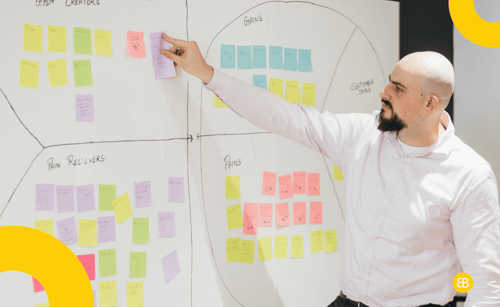Table of Contents
A Story-Driven Guide for Turning Conversations Into Customers Using the TAYA Framework
You Don’t Need More Leads. You Need More Follow-Through.
Let’s start with a story.
Emma, co-founder of a SaaS startup in Sydney, had just launched her new website. Beautiful design, strong traffic, clever lead magnets.
“We got 120 leads in our first month,” she told us during a discovery call. “We thought we were on fire.”
But when we asked how many leads became paying customers?
“Only 7 booked demos. The rest… just disappeared.”
Emma had what many businesses do: a leaky funnel.
Not a traffic problem. Not a product problem. A post-lead problem.
This blog will help you fix that.
Capturing a Lead Isn’t the Finish Line

Let’s get one thing straight:
The form fill is not a win. It’s just the start of a silent conversation.
When someone gives you their details, what they’re really saying is:
“I’m interested… but I’ve still got questions. Help me feel confident.”
If your next step is a boring auto-reply or a slow follow-up…
You’ve already lost the momentum.
As Jack Delosa says:
“A lead is a moment of trust. What you do next determines whether that trust turns into action.”
The Questions Every Lead Is Wondering (But Won’t Ask You)
This is where the They Ask, You Answer (TAYA) framework becomes your unfair advantage.
TAYA is simple but powerful:
You build trust by proactively answering the questions your leads are already asking in their heads.
Here are some of the things your leads might be thinking right now:
-
“How exactly does this work?”
-
“How much is it really going to cost me?”
-
“Is this the right fit for my business?”
-
“What happens if I change my mind?”
-
“Why should I trust this company over another one?”
Most businesses ignore these.
The smart ones—the trusted ones—lean in and answer them.
A Look Inside the Buyer’s Journey
Let’s flip the script.
Imagine you’re the buyer.
You’ve just submitted an enquiry form. You're curious, but cautious. You’ve got a budget to manage, a deadline to hit, and stakeholders to convince.
You check your inbox.
“Thanks for your interest. We’ll be in touch shortly.”
No context. No next steps. No real help.
So, what do you do?
You keep looking. You find another business who actually answers what you’re wondering.
They get the sale.
The 5-Step TAYA-Powered Lead Conversion Engine

Here’s the exact system we use at EB Pearls to help clients like Emma turn more of their captured leads into closed deals.
Step 1: Segment by Intent, Not Just Source
Not all leads are equal.
Some are ready to buy.
Others are just researching.
A few are comparing options.
Set up your CRM or lead forms to flag:
-
Page visited
-
Type of form submitted
-
Downloaded content (e.g., pricing guide)
Why it matters:
If you know what someone is really looking for, you can respond more meaningfully.
Step 2: Respond Fast—with Something Valuable
Speed matters. But value matters more.
Don’t just send:
“Thanks for your enquiry. We’ll be in touch.”
Instead, try this:
-
Link them to a relevant case study
-
Offer a short guide that answers their top 3 questions
“Hey Alex, thanks for reaching out! We help a lot of businesses in your space. Here's what happens next, and here’s a short guide that might help before our call.”
That one touchpoint can set the tone for the whole relationship.
Step 3: Build a Helpful, Honest Email Nurture Sequence
Structure your post-lead emails like this:
-
Welcome & what to expect
-
Success story (someone like them, with a great outcome)
-
Cost breakdown (transparent pricing)
-
Fit assessment (who you’re a great fit for—and who you’re not)
-
Objection handling (“What if it doesn’t work?”)
Each email should answer one unspoken question that your buyer is holding back.
Step 4: Turn Sales Calls Into Guided Conversations
Start your calls by saying:
“Based on what you shared and what we’ve seen in similar projects, I’ve mapped out 2–3 ways we might help. Want to walk through them?”
Be curious. Ask:
-
“What’s your biggest hesitation?”
-
“What’s your timeline?”
-
“What would success look like for you?”
When your lead feels heard, not sold to, they lean in.
Step 5: Don’t Let Cold Leads Stay Cold
Set up a win-back sequence:
-
A recent win from a client like them
-
A helpful resource based on their journey
-
A soft check-in:
“Still thinking about it? Here’s what’s changed since you reached out.”
This alone has helped our clients revive 10–15% of lost leads.
Alex Hormozi’s Value Equation (Why People Don’t Convert)
Entrepreneur Alex Hormozi says that people buy when value > price.
His value equation is one of the best tools for lead conversion:
Value = (Dream Outcome × Perceived Likelihood of Success) ÷ (Time Delay × Effort & Sacrifice)
Let’s break that down:
Dream Outcome
What’s the best possible result they want?
Tip: Paint the transformation. Don’t sell the app—sell the outcome.
Instead of “We’ll build your platform,” say: “You’ll onboard your first paying users within 4 weeks of launch.”
Perceived Likelihood of Success
Do they believe it will work for them?
Tip: Show proof with:
-
Case studies
-
Before/after stories
-
Transparent roadmaps
Time Delay
How long will it take to see results?
Tip: Offer quick wins.
Use phrases like: “You’ll have a working prototype within 14 days.”
Effort & Sacrifice
How hard will this be for me?
Tip: Reduce friction. “We handle everything. You focus on your business.”
Use this value equation to guide every email, page, and conversation.
If you increase Dream Outcome and Trust—and reduce Time Delay and Effort—you’ll win more customers without being pushy.
Metrics That Matter
| Metric | Why It Matters |
|---|---|
| Time to first response | Speed builds trust |
| Email open + click rate | Measures message relevance |
| Lead-to-call conversion | Shows lead quality and trust built |
| Sales call close rate | Reflects clarity and guidance |
| Cold lead reactivation | Reveals long-tail value of nurturing |
Back to Emma—What Changed
-
Her response time dropped to 3 minutes
-
Her emails became helpful and honest
-
Her sales calls felt like strategy sessions
-
She reactivated 22 cold leads
-
Conversions jumped from 7 to 32 in 60 days
“People now reply to our emails saying, ‘I’m in. When can we start?’” – Emma
Final Thought: People Don’t Convert Because You Followed Up.
They convert because you made them feel confident.
Confidence comes from clarity.
Clarity comes from answering questions.
That’s why TAYA + Hormozi is the winning combo.
Want Help Converting More Leads?
At EB Pearls, we don’t just build digital products.
We build post-lead systems that turn attention into action.
👉 Book a strategy session today.
Let’s create a post-lead journey so helpful your leads convert before the first call ends.
Frequently Asked Questions
Why aren’t my captured leads converting into sales?
What is the They Ask, You Answer (TAYA) framework and how does it help with lead conversion?
How quickly should I respond to new leads?
How can I segment leads to improve my follow-up process?
What kind of content should I send in my lead nurturing emails?

Akash, COO at EB Pearls, blends technical expertise with business acumen, driving the creation of successful products for clients.
Read more Articles by this Author